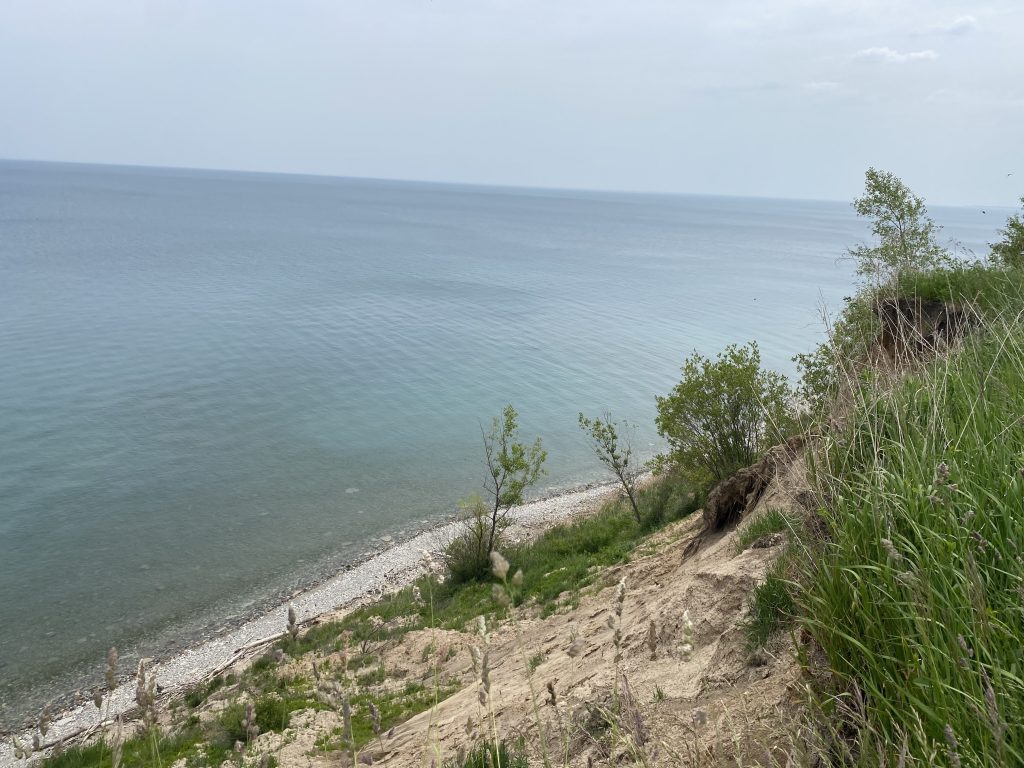Climate Change Threatens Milwaukee’s Coastline
New report documents big changes, multiple threats to miles of valuable coastline.

Coastal bluff in Warnimont Park. Photo by Graham Kilmer.
A new report shows how climate change is affecting weather patterns and local ecology in the Milwaukee area, and how all of it will impact the county’s beloved parks system, including the public’s many treasured, but vulnerable, coastal areas.
Milwaukee’s coastline has always been at the mercy of Lake Michigan’s rising and falling lake levels and the slow-acting erosion caused by its waves. But a changing climate means the ecological processes that are considered typical, or within average, will change too. And institutions will have to consider how it will affect Milwaukee’s valued coastline.
Milwaukee County Parks is responsible for maintaining many of the natural, and less developed areas, of the Milwaukee coastline. It’s been estimated that the county is responsible for approximately $2.9 billion worth of coastal assets. Most of that figure represents that held in trust for use by the public. So while it’s not land that will likely ever be up for sale, it will be expensive to maintain and protect.
The department recently worked with Mead & Hunt, an engineering consultant, to develop a Climate Resiliency Plan for the parks system. The plan uses Grant Park as a representative example of the effect climate change will have on county parks, given that it’s a regional park with many of the amenities and natural features found throughout the parks system.
The report looks at a variety of natural areas, infrastructure and amenities in the parks system. But many of the changing ecological processes associated with climate change overlap in their impact on the Great Lakes and Milwaukee’s coastline.
For instance, a primary feature of climate change is the general warming of the Earth’s atmosphere. Milwaukee, like many other places, is getting hotter. For instance, spring temperatures in the Midwest have increased on average by nearly 2 degrees since the middle of the 20th century, according to the report. Since 1980 the region has experienced “a period of rapid warming,” according to the report.
“It is no longer a question of if there will be hotter days, but a matter of when, how hot, and how often will Milwaukee see these changes,” the report notes.
Hotter summers are increasing evaporation rates and lowering lake levels. Lake levels naturally rise and fall. However, over the past decade, there have been both record-high and record-low lake levels. “The variability between the low- and high-water levels is one factor that leads to erosion,” according to the report.
For the lake, this has also meant rising temperatures. Since 1970, winter ice cover on the Great Lakes has decreased by approximately 63%.
“The area and duration of ice cover on the Great Lakes are used as indicators for a changing environment and climate,” according to the report. “Ice on the Great Lakes plays a significant role in the local ecology, economy, and ultimately the surrounding communities.”
Less ice cover will create conditions for bigger, stronger waves to batter the county’s shoreline.
“The increase in surface area favors wave growth overall, especially when there are strong winter winds moving across the Lakes,” the report notes. “The concern with increasing wave activity is that it leads to coastal damages including wetland and habitat loss.”
In 2020, winter storms battered Milwaukee County’s coastline, causing millions in damage. The cost of the storms to just county infrastructure was approximately $7 million, according to the parks department.
The storms caused huge chunks of Milwaukee’s coastal bluffs to fall off into the lake. The bluffs, carved by the advance of pre-historic glaciers, are also threatened by the increasing precipitation associated with climate change. Wisconsin recently experienced its wettest decade on record (2010 to 2019), according to the report. And since 1950, annual precipitation across the state has increased 17%, or five inches.
All this adds up to more rain and flooding and higher lake levels, which make coastal erosion and winter storms worse.
The county is already working on a long-term plan for protecting its coastal assets. In 2023 it began looking for a contractor to help it create a strategic plan addressing coastal erosion.
The challenge for county officials will be finding the funding to adapt coastal infrastructure in the short term and to implement a long-term strategy to protect them.
Read the full report on Urban Milwaukee.
If you think stories like this are important, become a member of Urban Milwaukee and help support real, independent journalism. Plus you get some cool added benefits.
MKE County
-
RNC Will Cause Some County Services To Be Moved to Wauwatosa
 Jul 12th, 2024 by Graham Kilmer
Jul 12th, 2024 by Graham Kilmer
-
Hank Aaron State Trail Will Be Closed For RNC, State Fair
 Jul 12th, 2024 by Graham Kilmer
Jul 12th, 2024 by Graham Kilmer
-
MCTS Designing New Bus Shelters
 Jul 10th, 2024 by Graham Kilmer
Jul 10th, 2024 by Graham Kilmer





















